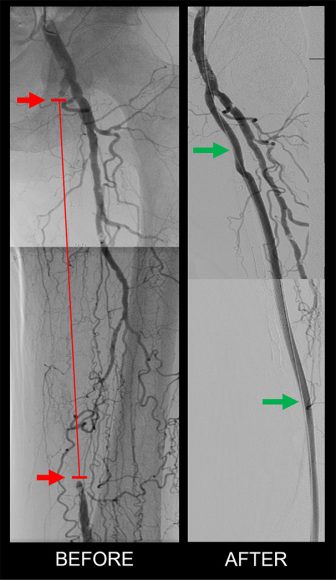St. Luke’s University Health Network vascular surgeons are the first in the area to offer a new incisionless procedure that restores blood supply to the leg by bypassing long, chronic total blockages in the main blood vessel of the leg called the superficial femoral artery.

A photo shows the dramatic improvement the PTAB procedure had on a St. Luke’s patient. The red path highlighted on the left is indicative of where the patient had no blood flow going down their femoral artery. The image on the right shows the blood flow that was reestablished via the DETOUR procedure, with blood now flowing through the stent that has been placed in the femoral vein. After blood flow has been restored to the leg, patients may walk painlessly, having avoided the need for amputation. (Credit: St. Luke’s University Health Network)
Percutaneous transmural arterial bypass, or PTAB, creates a bypass around the diseased artery with a Dacron-coated metal stent tube, branded as TORUS. This technology takes advantage of the fact that there is usually a large, healthy femoral drainage vein that runs right next to the blocked femoral artery.
St. Luke’s is the first hospital in the Lehigh Valley and northeastern Pennsylvania using this minimally invasive procedure, and one of only three in the state currently, noted St. Luke’s chief of vascular surgery, Sharvil Sheth, MD. This novel limb-saving treatment, called DETOUR by its manufacturer, Endologix, is currently being provided to patients with advanced peripheral artery disease (PAD) who are too high-risk to undergo surgery or have failed prior traditional balloon and stent treatments.
“This minimally invasive procedure has been proven to be a safe and effective treatment, and provides hope to several high-risk patients, who may also suffer from diabetes, kidney and heart disease,” Dr. Sheth said. “Restoring blood flow in a leg enhances the patient’s ability to walk painlessly, so they can partake in physical exercise, which helps improve their overall health.”
Unlike traditional methods for treating hardened blocked arteries, including balloon angioplasty and stents–which can have a higher rate of failure–or bypass surgery requiring multiple large incisions along the leg, in this PTAB technique, a surgeon passes a stent from healthy femoral artery in the groin into the adjacent femoral vein and then re-enters into healthy popliteal artery around the knee. It’s like taking a detour in a car, when one of the outbound lanes of the interstate highway is converted to an inbound lane in case of accident or construction, before it rejoins the original inbound lane. In the leg, the outbound lane is usually double the size of the inbound lane and can easily accommodate this extra traffic.
To date, St. Luke’s vascular surgeons Lynne Doctor, MD; Michael Qaqish, MD; and Sharvil Sheth, MD, have successfully treated three patients with this innovative technique. The incisionless bypass procedure takes place in a St. Luke’s hybrid operating room at its Allentown or Bethlehem campuses, requiring about two-and-a-half hours to complete. Patients are discharged the same day with a prescription for oral blood thinners.
Peripheral arterial disease is a narrowing or total blockage in the leg that affects about 12 to 19 million Americans. This condition occurs over time due to various risk factors such as smoking, diabetes, high blood pressure and cholesterol, which cause fatty deposits to develop in the wall of the blood vessel. These same risk factors can also narrow blood vessels in other parts of the body such as the heart, neck, brain, kidney and intestines.
Cardiovascular disease is the leading cause of death and disability in the U.S. In advanced cases, leg blockages can progress into non-healing foot wounds, gangrene and sometimes lead to partial or complete amputation of the foot or leg.
This community health news is brought to you in partnership with St. Luke’s University Health Network.







